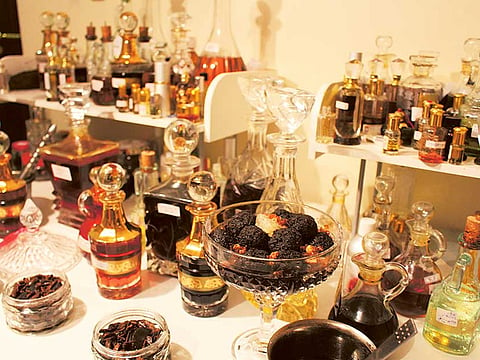Saudis wear 8 times more perfume than Europeans
Saudis uses 2.5 litres of perfume a year, while Europeans use just 300ml

Abu Dhabi: On average, a Saudi wears 2.5 litres of perfume a year, while Europeans use just 300ml, according to Fatima Khalil Al Ridha, a Saudi perfumery researcher and coach.
“This means Saudis wear perfumes eight times more than the Europeans,” Al Ridha said.
The total size of the perfume market in the Gulf is about $2.7 billion, and it is expected to grow by 3 per cent annually, with Saudi Arabia leading with the highest share of the perfume market in the Gulf by about 60 per cent, according to Euromonitor International.
Al Ridha, who was speaking at a lecture entitled ‘The World of Perfume Industry’ at the Abaad business incubator in Al Ahsa, indicated that animal welfare organisations have recently prevented the unjust killing of deer, cats and whales, to extract perfume ingrediants from their guts, and replaced that with scientific methods.
She explained that musk deer is the best, and it is the corrector for all perfumes, and it is the perfect addition to any aromatic note, explaining that International Fragrance Association (IFRA), has set a maximum of 40 per cent of the aromatic substance in perfumes, to be suitable for human use.
Any increased above that percentage exposes a perfume wearer to the risks of skin and respiratory diseases, including skin cancer.
IFRA offers as guidance for formulators and ingredients players looking to make sure their fragrance ingredient or product is safe and functional.
Al Ridha said the maximum stability of the smell, or the aromatic note, is 8 hours, according to the concentration ratios, indicating that the aromatic pyramid is composed of three parts, which are in order of disappearance: the top, the heart, the base, which remains for a long time, and it often contains heavy oils such as wood, amber, musk, rose and agarwood.
She attributed the main reason for the transformation of perfumes after a short period of time, from a pleasant smell to an unpleasant one, to the use of African alcohol. Al Ridha called for returning to nature in the perfume industry, by using our bounties on farms, setting up small factories for distilling and pressing plants and flowers, and extracting essential oils from them. For example: the use of palm fronds, and Al Ahsa lemon leaves to extract the scent of tar, and dates.
Perfumery has been a vital part of the Arab culture for thousands of years, and with the rise of Islam, the use of perfumery increased in the Arab world. Arabs and Persians would spend days travelling through the scorching desert to trade precious ingredients like saffron and wood. Other ingredients like amber, musk, henna, jasmine, frankincense (al lubaan), sandalwood and oud are vital in perfume making for Arabs. The Taif rose that grows in the valleys of Saudi Arabia is also a key ingredient.
The art of perfume making in the Arab world is preserved to this day. You will smell the lingering aroma of signature scents everywhere.
Arabian perfumes are traditionally alcohol-free. Apart from concentrated perfume oils, bakhoor or dukhoon (incense tablets), oud muattar (fragranced oud chips) and pure oud chips are very popular.
Sign up for the Daily Briefing
Get the latest news and updates straight to your inbox






![An aerial view shows Kingdom Tower in the Saudi capital Riyadh. [Illustrative image]](http://media.assettype.com/gulfnews%2Fimport%2F2020%2F05%2F26%2FSaudi-Riyadh_172500ec388_large.jpg?w=320&auto=format%2Ccompress&fit=max)
